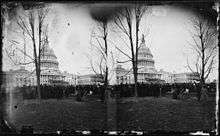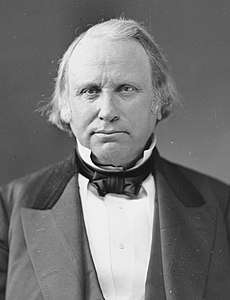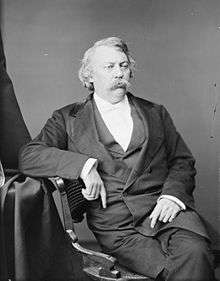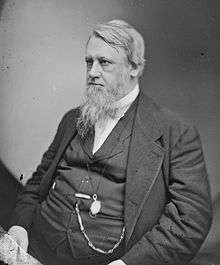43rd United States Congress
The 43rd United States Congress was a meeting of the legislative branch of the United States federal government, consisting of the United States Senate and the United States House of Representatives. It met in Washington, D.C. from March 4, 1873, to March 4, 1875, during the fifth and sixth years of Ulysses S. Grant's presidency . The apportionment of seats in the House of Representatives was based on the Ninth Census of the United States in 1870. Both chambers had a Republican majority.
| 43rd United States Congress | |
|---|---|
42nd ← → 44th | |
 United States Capitol (1869) | |
| March 4, 1873 – March 4, 1875 | |
| Senate President | Henry Wilson (R) |
| Senate President pro tem | Matthew H. Carpenter (R) Henry B. Anthony (R) |
| House Speaker | James G. Blaine (R) |
| Members | 74 senators 292 members of the House 10 non-voting delegates |
| Senate Majority | Republican |
| House Majority | Republican |
| Sessions | |
| Special: March 4, 1873 – March 26, 1873 1st: December 1, 1873 – June 23, 1874 2nd: December 7, 1874 – March 4, 1875 | |
Major events
- September 18, 1873: New York stock market crash triggered the Panic of 1873, part of the Long Depression
- November 4, 1874: United States House of Representatives elections, 1874 -Democrats regained control of the U.S. House of Representatives for the first time since 1860
- November 25, 1874: United States Greenback Party established as a political party, made primarily of farmers financially hurt by the Panic of 1873
Major legislation
- June 22, 1874: Revised Statutes of the United States
- June 23, 1874: Poland Act, 18 Stat. 253
- January 14, 1875: Specie Payment Resumption Act ch. 15, 18 Stat. 296
- March 1, 1875: Civil Rights Act of 1875, (Butler-Sumner Act) 18 Stat. 335
- March 3, 1875: Tariff of 1875
- March 3, 1875: Page Act of 1875, 18 Stat. 477
Treaties
- March 18, 1874: Hawaii signed a treaty with the United States granting exclusive trading rights.
Party summary
The count below identifies party affiliations at the beginning of the first session of this Congress, and includes members from vacancies and newly admitted states, when they were first seated. Changes resulting from subsequent replacements are shown below in the "Changes in membership" section.
Senate

| Party (shading shows control) |
Total | Vacant | ||||
|---|---|---|---|---|---|---|
| Democratic (D) |
Anti- Monopoly (AM) | Liberal Republican (LR) | Republican (R) | |||
| End of previous congress | 17 | 0 | 1 | 54 | 72 | 2 |
| Begin | 19 | 0 | 3 | 50 | 72 | 2 |
| End | 20 | 2 | 51 | 73 | 1 | |
| Final voting share | 27.4% | 0.0% | 2.7% | 69.9% | ||
| Beginning of next congress | 28 | 1 | 0 | 43 | 72 | 2 |
House of Representatives
Before this Congress, the 1870 United States Census and resulting reapportionment changed the size of the House to 292 members.
| Party (shading shows control) |
Total | Vacant | ||||||
|---|---|---|---|---|---|---|---|---|
| Democratic (D) |
Independent Democratic (ID) | Independent (I) | Independent Republican (IR) | Liberal Republican (LR) | Republican (R) | |||
| End of previous congress | 97 | 0 | 0 | 1 | 3 | 141 | 242 | 1 |
| Begin | 87 | 1 | 0 | 0 | 4 | 198 | 290 | 2 |
| End | 91 | 1 | 193 | |||||
| Final voting share | 31.4% | 0.3% | 0.0% | 0.3% | 1.4% | 66.6% | ||
| Beginning of next congress | 177 | 1 | 4 | 3 | 0 | 101 | 286 | 5 |
Leadership

Henry Wilson
Senate
- President: Henry Wilson (R)
- President pro tempore: Matthew H. Carpenter (R)
- Henry B. Anthony (R), elected January 25, 1875.
House of Representatives
- Speaker: James G. Blaine (R)
- Republican Conference Chairman: Horace Maynard
- Democratic Caucus Chairman: William E. Niblack
Members
This list is arranged by chamber, then by state. Senators are listed in order of seniority, and Representatives are listed by district.
Senate
Senators were elected by the state legislatures every two years, with one-third beginning new six-year terms with each Congress. Preceding the names in the list below are Senate class numbers, which indicate the cycle of their election. In this Congress, Class 1 meant their term ended with this Congress, requiring reelection in 1874; Class 2 meant their term began in the last Congress, requiring reelection in 1876; and Class 3 meant their term began in this Congress, requiring reelection in 1878.
Alabama
Arkansas
California
Connecticut
Delaware
Florida
Georgia
Illinois
Indiana
Iowa
Kansas
Kentucky
Louisiana
Maine
Maryland
Massachusetts
Michigan
Minnesota
|
Mississippi
Missouri
Nebraska
Nevada
New Hampshire
New Jersey
New York
North Carolina
Ohio
Oregon
Pennsylvania
Rhode Island
South Carolina
Tennessee
Texas
Vermont
Virginia
West Virginia
Wisconsin
|
 President pro tempore Matthew H. Carpenter  President pro tempore Henry B. Anthony
|
House of Representatives
The names of members of the House of Representatives are preceded by their district numbers.
Changes in membership
The count below reflects changes from the beginning of the first session of this Congress.
Senate
- replacements: 5
- Democratic: 1 seat net gain
- Republican: no net change
- Liberal Republican: 1 seat net loss
- deaths: 3
- resignations: 3
- interim appointments: 1
- vacancy: 1
- Total seats with changes: 7
| State (class) |
Vacator | Reason for change | Successor | Date of successor's formal installation[lower-alpha 1] |
|---|---|---|---|---|
| Massachusetts (2) | Vacant | Henry Wilson resigned in previous congress after becoming Vice President of the United States. Successor elected March 17, 1873. |
George S. Boutwell (R) | March 17, 1873 |
| Mississippi (1) | Adelbert Ames (R) | Resigned March 17, 1873, after being elected Governor of Mississippi. Successor elected February 3, 1874. |
Henry R. Pease (R) | February 3, 1874 |
| Kansas (2) | Alexander Caldwell (R) | Resigned March 24, 1873. Successor appointed November 24, 1873. |
Robert Crozier (R) | November 24, 1873 |
| California (1) | Eugene Casserly (D) | Resigned November 29, 1873. Successor elected December 23, 1873. |
John S. Hager (D) | December 23, 1873 |
| Kansas (2) | Robert Crozier (R) | Interim appointee retired when successor elected February 2, 1874. | James M. Harvey (R) | February 2, 1874 |
| Massachusetts (1) | Charles Sumner (LR) | Died March 11, 1874. Successor elected April 17, 1874. |
William B. Washburn (R) | April 17, 1874 |
| Connecticut (1) | William A. Buckingham (R) | Died February 5, 1875. Successor appointed February 5, 1875, having already been elected to the next tern. |
William W. Eaton (D) | February 5, 1875 |
House of Representatives
- replacements: 15
- Democratic: 3 seat net gain
- Republican: 4 seat net loss
- Liberal Republican: 1 seat net gain
- deaths: 8
- resignations: 5
- contested election: 4
- Total seats with changes: 19
| District | Vacator | Reason for change | Successor | Date of successor's formal installation[lower-alpha 1] |
|---|---|---|---|---|
| Louisiana 4th | Vacant | Rep-elect Samuel Peters died before taking seat | George L. Smith (R) | November 24, 1873 |
| Georgia 8th | Vacant | Rep-elect Ambrose R. Wright died before taking seat | Alexander H. Stephens (D) | December 1, 1873 |
| New York 6th | James Brooks (D) | Died April 30, 1873 | Samuel S. Cox (D) | November 4, 1873 |
| Massachusetts 3rd | William Whiting (R) | Died June 29, 1873 | Henry L. Pierce (R) | December 1, 1873 |
| Oregon At-large | Joseph G. Wilson (R) | Died July 2, 1873 | James Nesmith (D) | December 1, 1873 |
| Michigan 5th | Wilder D. Foster (R) | Died September 20, 1873 | William B. Williams (R) | December 1, 1873 |
| Virginia 5th | Alexander Davis (D) | Lost contested election March 5, 1874 | Christopher Thomas (R) | March 5, 1874 |
| Georgia 1st | Morgan Rawls (D) | Lost contested election March 24, 1874 | Andrew Sloan (R) | March 24, 1874 |
| New York 9th | David B. Mellish (R) | Died May 23, 1874 | Richard Schell (D) | December 7, 1874 |
| Arkansas 3rd | William W. Wilshire (R) | Lost contested election June 16, 1874 | Thomas M. Gunter (D) | June 16, 1874 |
| Ohio 12th | Hugh J. Jewett (D) | Resigned June 23, 1874, after becoming President of the Erie Railroad | William E. Finck (D) | December 7, 1874 |
| New York 3rd | Stewart L. Woodford (R) | Resigned July 1, 1874 | Simeon B. Chittenden (IR) | November 3, 1874 |
| South Carolina 3rd | Robert B. Elliott (R) | Resigned November 1, 1874 | Lewis C. Carpenter (R) | November 3, 1874 |
| Illinois 1st | John B. Rice (R) | Died December 17, 1874 | Bernard G. Caulfield (D) | February 1, 1875 |
| Massachusetts 10th | Alvah Crocker (R) | Died December 26, 1874 | Charles A. Stevens (R) | January 27, 1875 |
| Pennsylvania 23rd | Ebenezer McJunkin (R) | Resigned January 1, 1875 | John M. Thompson (R) | January 5, 1875 |
| Florida At-large | William J. Purman (R) | Resigned January 25, 1875 | Vacant | Not filled this term |
| Maine 4th | Samuel F. Hersey (R) | Died February 3, 1875 | Vacant | Not filled this term |
| Louisiana 1st | J. Hale Sypher (R) | Lost contested election March 3, 1875 | Effingham Lawrence (D) | March 3, 1875 |
Committees
Lists of committees and their party leaders, for members (House and Senate) of the committees and their assignments, go into the Official Congressional Directory at the bottom of the article and click on the link (1 link), in the directory after the pages of terms of service, you will see the committees of the Senate, House (Standing with Subcommittees, Select and Special) and Joint and after the committee pages, you will see the House/Senate committee assignments in the directory, on the committees section of the House and Senate in the Official Congressional Directory, the committee's members on the first row on the left side shows the chairman of the committee and on the right side shows the ranking member of the committee.
Senate
- Agriculture (Chairman: Frederick T. Frelinghuysen; Ranking Member: George R. Dennis)
- Appropriations (Chairman: Lot M. Morrill; Ranking Member: William B. Allison)
- Audit and Control the Contingent Expenses of the Senate (Chairman: Matthew H. Carpenter; Ranking Member: George R. Dennis)
- Civil Service and Retrenchment (Chairman: George G. Wright; Ranking Member: Timothy O. Howe)
- Claims (Chairman: John Scott; Ranking Member: George S. Boutwell)
- Commerce (Chairman: Zachariah Chandler; Ranking Member: George S. Boutwell)
- Distributing Public Revenue Among the States (Select)
- District of Columbia (Chairman: John F. Lewis; Ranking Member: John P. Jones)
- Education and Labor (Chairman: James W. Flanagan; Ranking Member: Oliver P. Morton)
- Engrossed Bills (Chairman: Thomas F. Bayard; Ranking Member: Henry Cooper)
- Finance (Chairman: John Sherman; Ranking Member: Thomas W. Ferry)
- Foreign Relations (Chairman: Simon Cameron; Ranking Member: Roscoe Conkling)
- Indian Affairs (Chairman: William A. Buckingham; Ranking Member: John J. Ingalls)
- Judiciary (Chairman: George F. Edmunds; Ranking Member: George G. Wright)
- Manufactures (Chairman: Thomas J. Robertson; Ranking Member: Reuben E. Fenton)
- Military Affairs (Chairman: John A. Logan; Ranking Member: Bainbridge Wadleigh)
- Mines and Mining (Chairman: Hannibal Hamlin; Ranking Member: George Goldthwaite)
- Mississippi River Levee System (Select)
- Naval Affairs (Chairman: Aaron H. Cragin; Ranking Member: Simon B. Conover)
- Ordnance and War Ships (Select)
- Outrages in Southern States (Select)
- Patents (Chairman: Orris S. Ferry; Ranking Member: William T. Hamilton)
- Pensions (Chairman: Daniel D. Pratt; Ranking Member: Morgan C. Hamilton)
- Post Office and Post Roads (Chairman: Alexander Ramsey; Ranking Member: John P. Jones)
- Private Land Claims (Chairman: Allen G. Thurman; Ranking Member: Thomas F. Bayard)
- Privileges and Elections (Chairman: Oliver P. Morton; Ranking Member: John H. Mitchell)
- Public Buildings and Grounds (Chairman: Justin S. Morrill; Ranking Member: John J. Patterson)
- Public Lands (Chairman: William Sprague; Ranking Member: Bainbridge Wadleigh)
- Railroads (Chairman: William M. Stewart; Ranking Member: Timothy O. Howe)
- Removal of Political Disabilities (Select)
- Retrenchment
- Revision of the Laws (Chairman: Hannibal Hamlin; Ranking Member: James L. Alcorn)
- Revolutionary Claims (Chairman: William G. Brownlow; Ranking Member: John W. Johnston)
- Rules (Select)
- Tariff Regulation (Select)
- Territories (Chairman: Arthur I. Boreman; Ranking Member: John J. Patterson)
- Transportation Routes to the Seaboard (Select) (Chairman: William Windom; Ranking Member: John H. Mitchell)
- Whole
House of Representatives
- Accounts (Chairman: James Buffington; Ranking Member: Alexander S. Wallace)
- Agriculture (Chairman: Charles Hays; Ranking Member: Sobieski Ross)
- Appropriations (Chairman: James A. Garfield; Ranking Member: James N. Tyner)
- Alabama Affairs (Select)
- Arkansas Affairs (Select)
- Banking and Currency (Chairman: Horace Maynard; Ranking Member: Jay Abel Hubbell)
- Claims (Chairman: John B. Hawley; Ranking Member: Julius C. Burrows)
- Coinage, Weights and Measures (Chairman: Samuel Hooper; Ranking Member: Horace B. Strait)
- Commerce (Chairman: William A. Wheeler; Ranking Member: Richard C. Parsons)
- District of Columbia (Chairman: Alfred C. Harmer; Ranking Member: Charles Pelham)
- Education and Labor (Chairman: James Monroe; Ranking Member: Alexander S. McDill)
- Elections (Chairman: Horace B. Smith; Ranking Member: Horace H. Harrison)
- Expenditures in the Interior Department (Chairman: Jackson Orr; Ranking Member: James C. Robinson)
- Expenditures in the Justice Department (Chairman: James B. Sener; Ranking Member: Robert M. Speer)
- Expenditures in the Navy Department (Chairman: Julius C. Burrows; Ranking Member: John A. Magee)
- Expenditures in the Post Office Department (Chairman: Henry W. Barry; Ranking Member: Pierce M. B. Young)
- Expenditures in the State Department (Chairman: Jasper Packard; Ranking Member: William R. Morrison)
- Expenditures in the Treasury Department (Chairman: J. Hale Sypher; Ranking Member: John G. Schumaker)
- Expenditures in the War Department (Chairman: William Williams; Ranking Member: John M. Bright)
- Expenditures on Public Buildings (Chairman: R. Holland Duell; Ranking Member: Henry O. Pratt)
- Freedmen's Affairs (Chairman: Clinton L. Cobb; Ranking Member: J. Allen Barber)
- Foreign Affairs (Chairman: Godlove Stein Orth; Ranking Member: William J. Albert)
- Indian Affairs (Chairman: John T. Averill; Ranking Member: John D. Lawson)
- Invalid Pensions (Chairman: Jeremiah McLain Rusk; Ranking Member: William B. Small)
- Judiciary (Chairman: Benjamin F. Butler; Ranking Member: Alexander White)
- Manufactures (Chairman: Charles B. Farwell; Ranking Member: Laurin D. Woodworth)
- Mileage (Chairman: Hezekiah S. Bundy; Ranking Member: James W. Nesmith)
- Military Affairs (Chairman: John Coburn; Ranking Member: Clinton D. MacDougall)
- Militia (Chairman: Roderick R. Butler; Ranking Member: Josiah T. Walls)
- Mines and Mining (Chairman: David P. Lowe; Ranking Member: Christopher C. Sheats)
- Naval Affairs (Chairman: Glenni W. Scofield; Ranking Member: John H. Burleigh)
- Pacific Railroads (Chairman: Philetus Sawyer; Ranking Member: James W. McDill)
- Patents (Chairman: Omar D. Conger; Ranking Member: Henry B. Sayler)
- Post Office and Post Roads (Chairman: John B. Packer; Ranking Member: Stephen A. Cobb)
- Private Land Claims (Chairman: Jasper Packard; Ranking Member: James C. Freeman)
- Public Buildings and Grounds (Chairman: James H. Platt, Jr.; Ranking Member: Lloyd Lowndes, Jr.)
- Public Expenditures (Chairman: Harrison E. Havens; Ranking Member: Josiah W. Begole)
- Public Lands (Chairman: Washington Townsend; Ranking Member: William A. Phillips)
- Railways and Canals (Chairman: George W. McCrary; Ranking Member: Alexander W. Taylor)
- Reform on Civil Service (Chairman: Stephen W. Kellogg; Ranking Member: James D. Strawbridge)
- Revision of Laws (Chairman: Luke P. Poland; Ranking Member: William S. Moore)
- Revolutionary Pensions and War of 1812 (Chairman: Lazarus D. Shoemaker; Ranking Member: William Crutchfield)
- Rules (Select) (Chairman: James G. Blaine; Ranking Member: Samuel S. Cox)
- Standards of Official Conduct
- Territories (Chairman: George C. McKee; Ranking Member: Greenbury L. Fort)
- War Claims (Chairman: William Lawrence; Ranking Member: Abraham H. Smith)
- Ways and Means (Chairman: Henry L. Dawes; Ranking Member: Lionel A. Sheldon)
- Whole
Joint committees
- Conditions of Indian Tribes (Special)
- Enrolled Bills (Chairman: Rep. Chester B. Darrall; Vice Chairman: Rep. Henry R. Harris)
- Inquire into the Affairs of the District of Columbia (Select) (Chairman: Rep. Jeremiah M. Wilson; Vice Chairman: Rep. Hugh J. Jewett)
- The Library (Chairman: Rep. William P. Frye; Vice Chairman: Rep. Hiester Clymer)
- Printing (Chairman: Rep. William G. Donnan; Vice Chairman: Rep. Alfred M. Waddell)
Caucuses
- Democratic (House)
- Democratic (Senate)
Employees
Legislative branch agency directors
Senate
- Chaplain: John P. Newman (Methodist), until December 8, 1873
- Byron Sunderland (Presbyterian), elected December 8, 1873
- Librarian: George S. Wagner
- Secretary: George C. Gorham
- Sergeant at Arms: John R. French
House of Representatives
- Chaplain: John G. Butler (Presbyterian)
- Clerk: Edward McPherson
- Clerk at the Speaker’s Table: John M. Barclay
- Doorkeeper: Otis S. Buxton
- Postmaster: Henry Sherwood, elected December 1, 1873
- Reading Clerks: Charles N. Clisbee (D) and William K. Mehaffey (R)
- Sergeant at Arms: Nehemiah G. Ordway
See also
- United States elections, 1872 (elections leading to this Congress)
- 1872 United States presidential election
- United States Senate elections, 1872 and 1873
- United States House of Representatives elections, 1872
- United States elections, 1874 (elections during this Congress, leading to the next Congress)
- United States Senate elections, 1874 and 1875
- United States House of Representatives elections, 1874
Notes
- This is the date the member was seated or an oath administered, not necessarily the same date her/his service began.
References
- Martis, Kenneth C. (1989). The Historical Atlas of Political Parties in the United States Congress. New York: Macmillan Publishing Company.
- Martis, Kenneth C. (1982). The Historical Atlas of United States Congressional Districts. New York: Macmillan Publishing Company.
External links
- Statutes at Large, 1789-1875
- Senate Journal, First Forty-three Sessions of Congress
- House Journal, First Forty-three Sessions of Congress
- Biographical Directory of the U.S. Congress
- U.S. House of Representatives: House History
- U.S. Senate: Statistics and Lists
- Congressional Directory for the 43rd Congress, 1st Session.
- Congressional Directory for the 43rd Congress, 1st Session (1st Revision).
- Congressional Directory for the 43rd Congress, 1st Session (2nd Revision).
- Congressional Directory for the 43rd Congress, 2nd Session.
- Congressional Directory for the 43rd Congress, 2nd Session (Revision).

